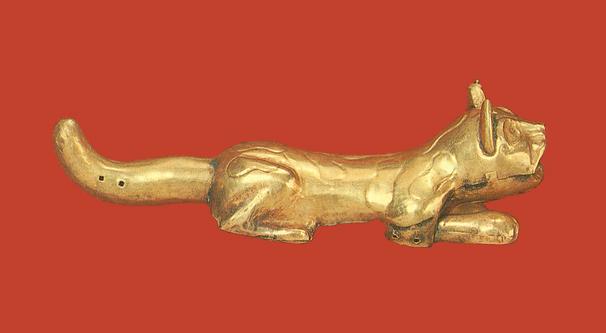 Milwaukee Public Museum |
This article appeared in South American Explorer, No. 77, Fall 2004/Winter 2005.
 Milwaukee Public Museum |
|
THE CURIOUS LEGACY OF PAMPA GRANDE
By Victor Miguel Ponce and Jenny Flores Valera |
| The ancient Huaca of Pampa Grande, in northern Peru, is the most impressive monument of am ancient culture that flourished in this arid and coastal region centuries ago. Pizarro is said to have marveled at the site when camping nearby in the early 1530s on his way to Cajamarca and the conquest of the Inca empire. The majestic Huaca "La Capilla" of Pampa Grande is venerated far and wide, but the curious story of its legendary seven hollow, gold jaguars has captured the imagination of archaeologists and laymen alike. |
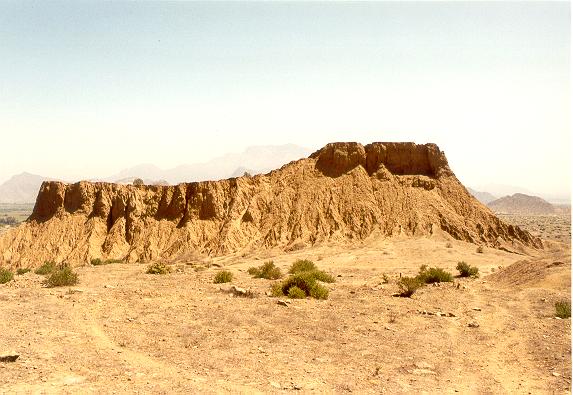 Photo by V. M. Ponce |
| Huaca "La Capilla" in Pampa Grande, near Chiclayo, Peru (2004). |
|
Chavinoide Influence
Pampa Grande, near the northern Peruvian city of Chiclayo, dates back 2000 years. The best testimonies to its past grandeur are seven hollow, gold jaguars. These were on the site of the Huaca of Pampa Grande in 1925. To see all seven pieces today you must travel to museums in the United States, Canada, Germany, and Peru. American archaeologists were the first to study the jaguars. In 1975 a team of specialists concluded that given the extraordinary similarity of the different jaguars, it was almost certain that had been crafted in a single workshop, although one or more artisans may have had a hand in their creation. The jaguars are conceivably "Chavinoid" in appearance, but are most probably proto-Mochica or early Vicus, and if so, date back to roughly 400-100 B.C. The dimensions of the hollow gold jaguars are approximately 10.8 cm [4.25 in] long, 3 cm [1.18 in] wide, and 2.9 cm [1.14 in] tall. Each weighs about 21 grams [0.74 oz]. 1
Mochica Influence Though the site is considerably older, Mochica influence in Pampa Grande flourished between 550 and 700 A.D. Evidence of this advanced culture can be seen in the ruins of eighteen buildings or "huacas," spread over an area of 300 ha [740 ac]. The more monumental of these structures is the Huaca "La Capilla," also known as "La Fortaleza." In size, this huaca ranks third among precolumbian pyramids in Latin America. Constructed in six terraces, with an access ramp 250 m [820 ft] long, "La Capilla" soared to a height of 50 m [164 ft]. A large defensive wall that included many secondary buildings surrounded the huaca. Construction of such a massive edifice is evidence of the enormeous efforts of the local population, and their skills in crafts, metallurgy, and ceramics. The Mochicas maintained control over the irrigation in the entire Chancay river valley and their well-stocked silos silos aroused the envy of their neighbors.
Lambayeque Influence If one believes the ancient legend of Naylamp and various chronicles, the Lambayeque culture dominated Pampa Grande's history between between 900 and 1000 A.D. This came about when Cuntipallec, son of Cium (Naylamp's heir and Second Lord of the valley) settled the Collique valley between Pampa Grande and neighboring Cayalti. He brought with him the customs and culture of his native Lambayeque, which spread throughout the region.
Chimu Influence Around 1400 A.D. Fempellec, the Lord of Lambayeque, died without descendants leaving the region without a lord. During this time Chimo Capac, lord of the region to the south, invaded, conquering Pampa Grande. Chimu influence is evident in Pampa Grande during this period between 1400-1471 and a period in which Pampa Grande and the valley was ruled by Chimo Capac's trusted lieutenant, Pongmassa, and after his death by his son Oxa. The Chimu built the hydraulic systems running through the valley, some of which, like the Collique canal, still criss-cross the valley, and are in use today. During Oxa's rule, the Chimu came under the threat of the Incas in Peru and in 1471 the Incas swept into the valley.
Inca Influence The Incas took control of the region, leaving the Chimu in possession, provided they paid allegaince to the new regime and worshiped the Inca sun god. Subsequently, Tupac Yupanqui forced the population of Collique to resettle in Cajamarca, in the central Andean highlands. The last Inca to rule the region was Chanda Huaman, who was residing in Cajamarca with Atahualpa when the Spaniards arrived in the early 1530s. Pizarro ascended the Andes from the headwaters of the Chancay valley. Near Pampa Grande, he stopped to marvel at the Huaca "La Capilla," the walled fortress, as he bivouacked en route.
Until 1550, Collique was an "encomienda" of the Spaniard Blas de Atienza. It was then merged with the encomienda of Cinto (today Pátapo and Pucalá). The purpose of the merger was to better fulfill the goal of the ordenanza, which was to bring religion to the natives. The two encomiendas became a single town-Chicliaep, the precursor to the modern city of Chiclayo.
|
|
Baca's account is given below [Translation by Victor Ponce]:
"In the summer of 1925, torrential rains fell upon the northern coast of Peru. Heavy rains caused floods in the department of Lambayeque, turning rivers into muddy torrents. On March 18, officials measuring the water volume of the Chancay river at "La Puntilla" registered a flow of 1,000 cubic meters per second.Although Victor Baca knew of the discovery of six jaguars, it now appears that there were more. We now know of a seventh jaguar, the jaguar of Munich, now in the Museum für Völkerkunde. This is not at all surprising, since the peasant who originally discovered the jaguars sold a number before Victor Baca learned of their existence. He bought two that remained in his family, but the others were disposed of almost immediately after their discovery. At this point there is no way to know what might have been the original number. |
|
| Jaguar of Munich. |
|
The jaguars are all made of a similar sheet metal whose composition is 9% copper, 15% silver, and 76% gold. However, the surfaces of the sheet metal are enriched in gold, for the average surface composition of the metal is 3% copper, 12% silver, and 85% gold. The metal sheet used for all jaguars is remarkably uniform in thickness. This is evident in the closeness in weight of the specimens, since the jaguars are virtually identical in size. Each animal is composed of twelve individual pieces. The body has an upper and a lower portion, joined along their common edges. Each extremity (tail, ears, and front legs) is made of halves, joined along their midline. The jaguars were assembled by joining the extremities to the body after the top and bottom body parts themselves had been joined. There are variations in the jaguars that are noticeable upon comparison. These were almost certainly introduced by a group of goldsmiths working on the objects at different times or at different stages in their manufacture, or by the normal idiosyncracies of a single craftsman who produces the same object many times in succession and does it slightly differently each time. In general, the similarities among the jaguars far outweight their differences; the characteristics they share virtually preclude the possibility that any one was made independently of the others. |
 Art Institute of Chicago |
| Jaguar of Chicago. |
|
Victor Miguel Ponce
is a regular contributor and advisor to
South American Explorer. He teaches civil engineering at San Diego State University and welcomes visitors
to his website http://ponce.sdsu.edu
Jenny Flores Valera is president of the Centro de Promoción Turístico-Cultural "Pampa Grande-Moche" and curator of the pottery collection in Pampa Grande. |
| 1 Lechtman, H., L. A. Parsons, and W. J. Young. 1975. Seven matched hollow gold jaguars from Peru's Early Horizon. Studies in Pre-columbian art and archaeology, Number Sixteen. Dumbarton Oaks • Trustees for Harvard University, Washington, D.C. |
| How to reach Pampa Grande. From Lima, Peru, head north about 780 km [487 miles] to Chiclayo, by either plane or bus. The plane ride is about one hour; the bus ride is ten hours. Pampa Grande is located along the left margin of the Chancay river, 28 km [18 mi] east of Sipan's Huaca Rajada, and 58 km [36 mi] east of Chiclayo. The Centro de Promoción Turístico-Cultural "Pampa Grande-Moche," which houses the pottery collection, is located in Calle La Fortaleza, near the entrance to the town. From there, it is a 15-minute walk to the Huaca "La Capilla." |
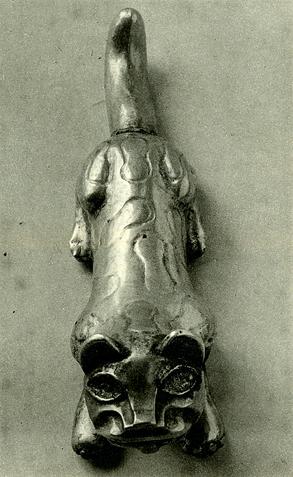 Museum für Völkerkunde, Hamburg |
| Jaguar of Hamburg. |
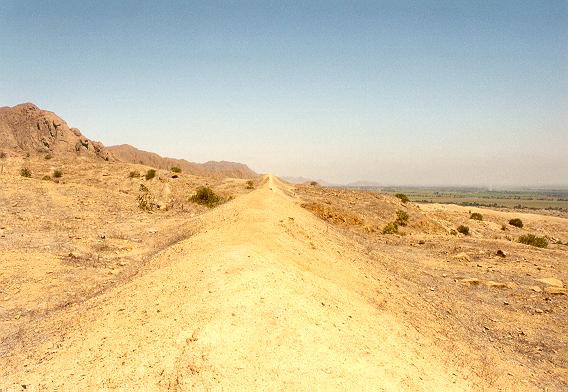 Photo by V. M. Ponce |
| Defensive wall surrounding the Huaca "La Capilla" in Pampa Grande (2004). |
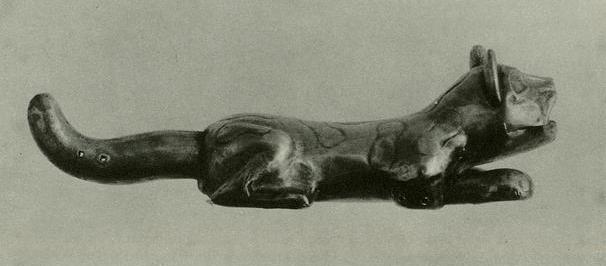 Milwaukee Public Museum |
| Jaguar of Milwaukee. |
| 050512 |